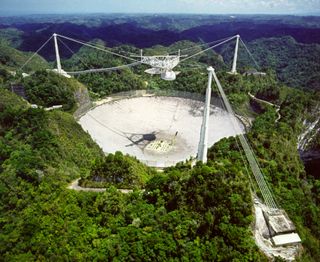How GoldenEye's Arecibo Observatory became a scientific and cultural icon
A tale of telescopes and James Bond.


This article first appeared in PC Gamer magazine issue 353 in February 2021, as part of our 'Tech Report' series. Every month we explore and explain the latest technological advances in computing—from the wonderful to the truly weird—with help from the scientists, researchers, and engineers making it all happen.
A disjointed, globe-spanning story this month, that takes in the island of Puerto Rico, the University of Milwaukee, spinning neutron stars at the edge of the galaxy, and your PC, via James Bond and a Battlefield 4 multiplayer map.
Where to start? Well, in the late 1950s, nuclear missiles re-entering the atmosphere as part of a Soviet attack were considered to be a bit of a worry. The missiles dropped radar-reflective decoys behind them, and nobody knew enough about the upper levels of the atmosphere to tell the difference between these dummies and the real warheads coming in hot. One way to get this information, it was decided, was to build an enormous radio telescope—a huge dish 1,000ft across—reclined inside a sinkhole on Puerto Rico.
Suspended above this dish would be a 190-ton platform carrying the receivers that would read the radio waves focused by the telescope. This platform also needed to be mobile, because moving the dish itself was going to be impossible. And so it was built, officially opened in 1963, a triumph of cold war engineering. When not looking for incoming nukes or bouncing signals off the Moon to find Soviet radar installations, the dish turned out to have other uses in the field of astronomy, and was soon showing results. It discovered that Mercury rotates once every 59 days instead of the previously believed 88, meaning it was not tidally locked to the Sun. It made the first radar observations of a comet, discovered the first extrasolar planets, and in 1968 provided the first evidence for the existence of neutron stars, by timing the periodicity of the Crab Pulsar.

Pulsars, as you probably already know, are spinning neutron stars that emit beams of electromagnetic radiation from their poles. Every time the star rotates, assuming it's pointing in the right direction, the beam sweeps across the detector, producing a pulse rather like that of a lighthouse if lighthouses blinked at up to 700 times a second. The pulses were first observed on November 28, 1967, by Jocelyn Bell Burnell and Antony Hewish in the faint constellation Vulpecula (found in the centre of the Summer Triangle asterism, sky fans). The signal was jokingly named ‘Little Green Men 1', but further discoveries from other regions of the sky ruled out an alien civilisation. As the science became more precise, it was possible to detect minute differences in the pulses put out by a particular pulsar, and in this way the first planets orbiting a star other than the Sun were discovered.
Discovering these enigmatic celestial metronomes is the purpose of Einstein@home (einsteinathome.org), a distributed computing project centred on the University of Milwaukee that you can run on your home PC in the same vein as Folding@home, using exactly the same BOINC software. It takes data from the Arecibo telescope as well as the LIGO gravitational-wave detectors and the Fermi gamma-ray satellite, and sends it out to be processed on its volunteer network. So far, it's had success in discovering around 50 new radio pulsars and 25 previously unknown gamma-ray sources.

Tick tock
Pulsars are useful to science because they are some of the most regular clocks in existence. Changes in their blink rate can point to disturbances in the space around them but also, as they are themselves moving through space, they can be used to calculate distances on the cosmic scale and to test theories such as Einstein's general relativity. Their regular pulses may also be interrupted by the passage of gravitational waves, giving us a second method of detecting these alongside LIGO's laser interferometer method.
Arecibo was also the source of the data chewed through by the now-defunct SETI@home project, searching for evidence of alien civilisations via their radio emissions. At the time of writing, the number of such cultures detected remains at zero.
The biggest gaming news, reviews and hardware deals
Keep up to date with the most important stories and the best deals, as picked by the PC Gamer team.
Sadly, time has not been kind to the Arecibo telescope. Its structure of towers and cables, the weight of the receiving platform and its position near the tropics made it vulnerable to natural events, and so it was. In 2017 a hurricane brought down one of its feed lines, damaging the surface of the dish. In August 2020 another cable broke, further gashing the dish. Then in November the same year two more cables snapped, putting a large hole in the dish. The decision was taken to decommission and demolish the observatory, but the telescope took things into its own hands in early December, with the failure of three cables causing the receiving platform to fall onto the dish, shearing the tips from the support towers as it did. No one was injured, but 190 tons falling from 150m does a lot of damage to aluminium, it turns out.

The baton will be taken up by other large telescopes, including China's FAST, the Square Kilometre Array, and future installations such as the Lunar Crater Radio Telescope, currently an early-stage proposal at NASA to be built on the far side of the Moon in a crater three to five kilometres across and surely the setting of a future COD map. The benefits of this would be removing the effects of the Earth's atmosphere completely (some radio frequencies are almost completely unexplored because they do not penetrate our atmosphere), and blocking out interference from all the radio equipment currently on Earth.
It's a sad end for such an icon of scientific discovery and first-person shooters—it appears in both the film and game adaptation of GoldenEye, the book and movie Contact, and an episode of The X Files (called Little Green Men), and while the radio telescope in a sinkhole depicted in the Battlefield 4 map Rogue Transmission is said to be in China, it bears enough similarities to Arecibo (including the three concrete pillars and distinctive domed Gregorian reflector that China's similar FAST telescope doesn't have) to make the inspiration clear. Goodbye Arecibo, we enjoyed running around shooting people underneath you. Especially Sean Bean. And you did some great science too.

Ian Evenden has been doing this for far too long and should know better. The first issue of PC Gamer he read was probably issue 15, though it's a bit hazy, and there's nothing he doesn't know about tweaking interrupt requests for running Syndicate. He's worked for PC Format, Maximum PC, Edge, Creative Bloq, Gamesmaster, and anyone who'll have him. In his spare time he grows vegetables of prodigious size.
Most Popular

